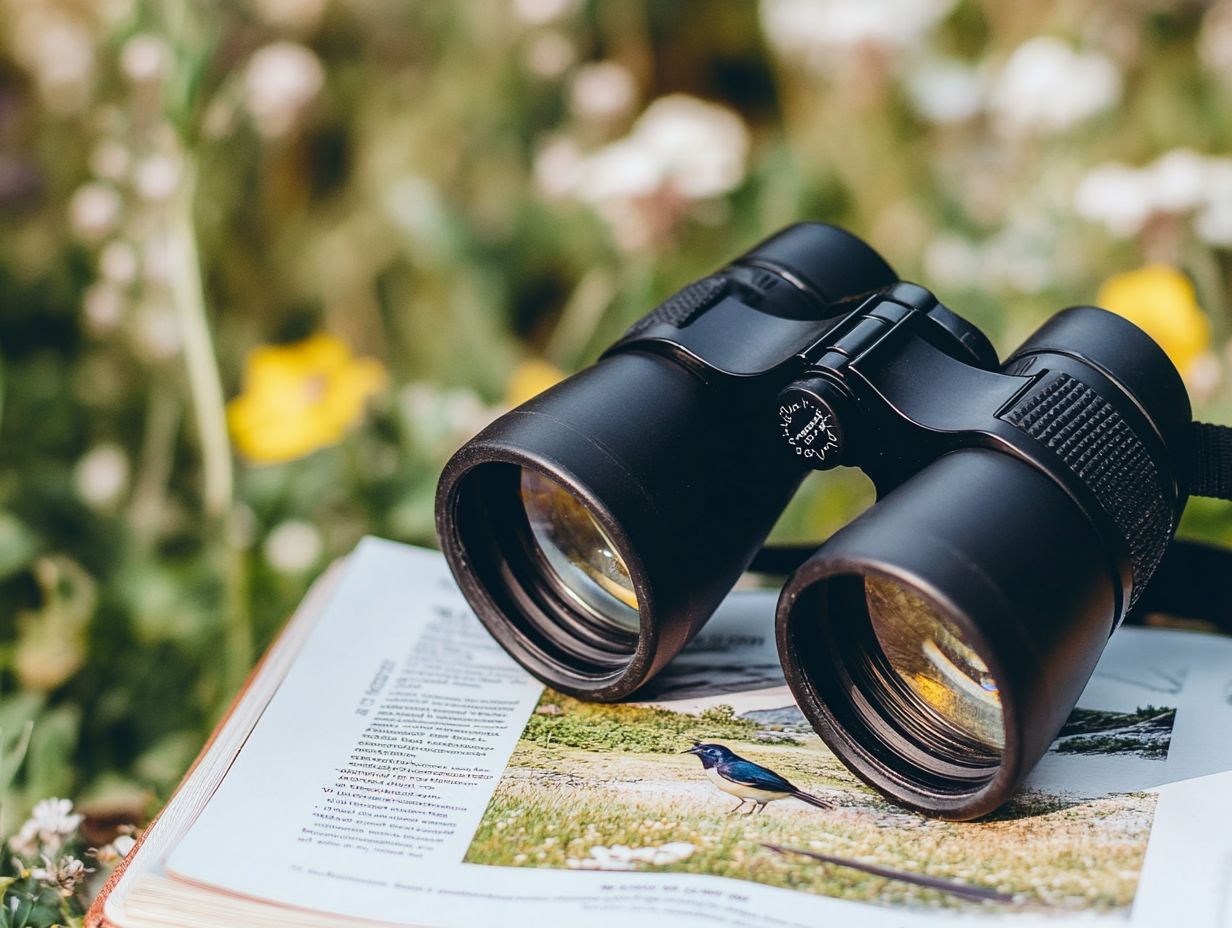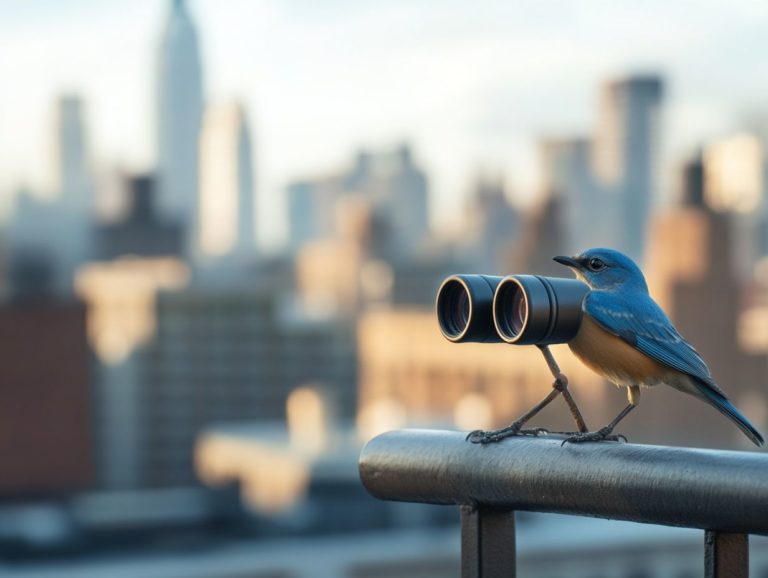Understanding Binocular Terminology for Birders
Birdwatching is an enriching hobby that fosters a deep connection with nature, and possessing the right tools can truly elevate your experience.
Binoculars are indispensable for spotting and identifying birds from afar. They transform an ordinary outing into a memorable adventure.
This guide delves into essential binocular terminology, highlights key features to consider, and outlines the factors that will help you select the perfect pair for your birding escapades. It also provides valuable tips on maintaining your binoculars, ensuring they remain reliable companions for many years to come.
Contents
- Key Takeaways:
- Understanding Binocular Terminology
- Choosing the Right Binoculars for Birding
- Maintaining and Caring for Your Binoculars
- Frequently Asked Questions
- What does “field of view” mean when talking about binoculars?
- What is the difference between magnification and objective lens size?
- What is the best magnification for bird watching?
- What does “exit pupil” mean?
- What is the difference between roof prism and porro prism binoculars?
- What is ED Glass and Why is it Important for Birding Binoculars?
Key Takeaways:

Why Binoculars are Essential for Birding
Every birding enthusiast needs binoculars to unlock the beauty of nature! They offer the clear vision necessary for effective observation and identification of birds.
In the field, you rely on high-quality binoculars to enhance your experiences, allowing you to appreciate intricate details in feather patterns, behaviors, and habitats. Connecting with nature enhances your joy of birdwatching and fosters a greater appreciation for these magnificent creatures, playing a vital role in conservation efforts.
Consider features like wide fields of view and lightweight designs. These enable you to effortlessly track fast-moving species. Advanced lens coatings reduce glare and boost light transmission, making it easier for you to spot those elusive birds, even in low-light conditions.
As you hone your skills in identifying various species, you often find yourself feeling a sense of responsibility to preserve their habitats. This enhanced observation experience, made possible by quality binoculars, inspires you to support conservation initiatives, ultimately contributing to the protection of avian populations and their ecosystems.
Understanding Binocular Terminology
When selecting binoculars, understanding binocular terminology can make a huge difference in your experience. It encompasses key elements such as optical quality, objective lens sizes, minimum focus distance, and field of view.
Whether you’re a novice or an experienced birder, having a firm grasp of these terms can greatly enhance your binocular buying journey. Understanding the importance of binoculars in birding ensures that you find the perfect pair tailored precisely to your unique needs.
Key Features to Consider
When you’re shopping for binoculars, it s essential to consider key features like magnification levels think 8×42, 10×42, and 7×42 along with the type of prism used. These factors can greatly influence light gathering and overall optical performance.
You ll need to decide between weatherproof binoculars and zoom binoculars, keeping in mind how each option caters to different birding environments and personal preferences.
Selecting the right magnification can truly elevate your birdwatching experience, allowing you to spot birds from impressive distances while maintaining clarity. For example, an 8×42 magnification strikes a perfect balance between a broader field of view and the ability to capture intricate details, making it ideal for observing birds in flight or hidden within foliage.
The type of prism roof or Porro also plays a significant role in delivering sharp images and compact designs that are perfect for field use. If you often find yourself in nature s unpredictable elements, weatherproof binoculars are a must. They re built to withstand moisture and dust, ensuring your observations remain uninterrupted, no matter what Mother Nature throws your way.
Start your birdwatching journey today using the right binoculars!
Commonly Used Terms in Birding

In the world of birding, understanding terms like field of view and close focus is essential for enhancing your bird observation experience. Familiarizing yourself with these concepts, along with using binoculars effectively for bird identification, not only improves your skills but also enriches communication with fellow birders.
This knowledge deepens your appreciation for avian species in their natural habitats.
Field of view refers to how much you can see around you at once. A broader field of view helps you spot and track birds in different settings, making it invaluable for any enthusiast.
Close focus emphasizes your ability to observe birds at close range. This reveals intricate details of their plumage and behavior, nurturing a profound appreciation for the biodiversity around you.
Choosing the Right Binoculars for Birding
Choosing the right binoculars can transform your birdwatching adventures into something extraordinary! Consider key factors such as optical quality, comfort, and durability.
A detailed buying guide for binoculars should cater to your needs as a birder. It will help you navigate the myriad of models and brands available.
Focus on binoculars equipped with premium optics to elevate your performance and usability in the field.
Factors to Consider
When choosing binoculars for birdwatching, weigh key factors like magnification, objective lens size, weatherproof features, and minimum focus distance.
Each element significantly shapes your birdwatching experience. Understanding how they interact will help you make an informed choice that delivers optimal performance.
The magnification determines how close and detailed your view of the birds becomes. Meanwhile, the objective lens size influences brightness and clarity in varying lighting.
Consider weatherproof features if your birding takes you into damp environments where moisture could affect functionality.
Minimum focus distance is crucial for spotting nearby birds. A wide field of view enhances your situational awareness, making it easier to track fast-moving creatures.
Recommended Brands and Models
If you re a discerning birder seeking high-quality optics, brands like Zeiss, Leica, and Swarovski are often at the top of the list. Their commitment to premium optics and innovative designs has won them a special place in the birding community.
These manufacturers offer binoculars that excel in light transmission, exceptional clarity, and robust construction. They are built to endure the demands of outdoor observation.
For instance, the Zeiss Victory SF is celebrated for its wide field of view and ergonomic design an ideal companion for long hours spent birdwatching.
Leica’s Noctivid stands out by providing bright images and remarkable depth of field, making it a top choice for enthusiasts who value detail in various lighting conditions.
The American Birding Association and Cornell Lab of Ornithology provide valuable insights for selecting the right equipment. They guide you toward models that truly enhance your experience, ensuring you don t miss a single moment of avian action.
Maintaining and Caring for Your Binoculars

Maintaining and caring for your binoculars is essential for ensuring their long life and great performance. This enables you to enjoy clear and reliable views throughout the seasons.
By adhering to tailored tips for both standard and weatherproof binoculars, you can safeguard your investment and enhance your birdwatching experience, ultimately extending the life of your precious optical equipment.
Tips for Longevity and Optimal Performance
Want your binoculars to last? Here s how to keep them in top shape. Master proper cleaning techniques, effective storage solutions, and understand features that keep binoculars safe from rain and fog.
When cleaning your binoculars, use a soft, lint-free cloth to gently wipe the lenses, removing dust and smudges. A lens cleaning solution can enhance clarity without causing any damage.
For storage, keeping your binoculars in a padded case is a wise choice. It shields them from physical impacts and temperature fluctuations, protecting those delicate components.
Invest in binoculars with fog-proof seals and waterproof housing to explore various terrains confidently, without the constant worry of moisture or fogging.
Using these strategies will help you enjoy consistent viewing experiences, no matter what the elements throw at you.
Frequently Asked Questions
What does “field of view” mean when talking about binoculars?
Field of view refers to how much of the area around you can be seen through the binoculars. A wider field of view allows you to see more surroundings, which is beneficial for spotting birds in flight or among dense foliage.
What is the difference between magnification and objective lens size?

Magnification indicates how much closer an object appears when viewed through the binoculars. The objective lens size, however, is the diameter of the lenses at the front of the binoculars. Both factors impact the overall performance of the binoculars for birding.
What is the best magnification for bird watching?
The best magnification for bird watching typically falls between 8x and 10x. Higher magnifications may result in a narrower field of view and shakier images, making it more difficult to spot and track birds in their natural habitat.
What does “exit pupil” mean?
Exit pupil is the size of the circle of light that enters your eye when looking through the binoculars. You can find it by dividing the objective lens size by the magnification. A larger exit pupil can be beneficial for low light conditions, but if it is too large, it may result in a dimmer image.
What is the difference between roof prism and porro prism binoculars?
Roof prism and porro prism refer to the type of prism used in the design of binoculars. Roof prism binoculars have a straight barrel design, making them more compact and lightweight. Porro prism binoculars have a more traditional Z-shaped design, providing a wider field of view and often a more affordable option.
Start caring for your binoculars today to enjoy clearer views!
What is ED Glass and Why is it Important for Birding Binoculars?
ED glass stands for Extra-low Dispersion glass. This type of glass is used in binocular lenses to reduce chromatic aberration, which means it helps eliminate color distortions.
With ED glass, you get sharper images, making birdwatching an exhilarating experience as you spot even the tiniest details of distant birds!






